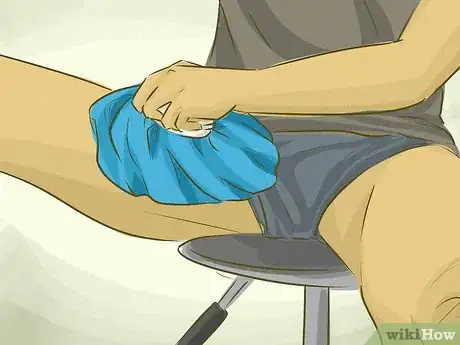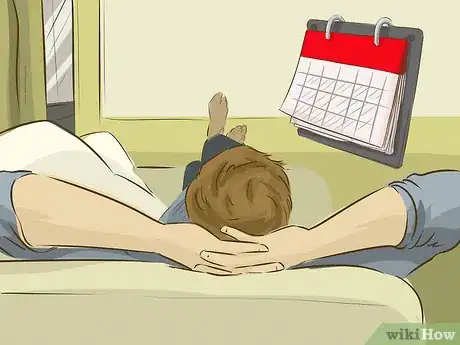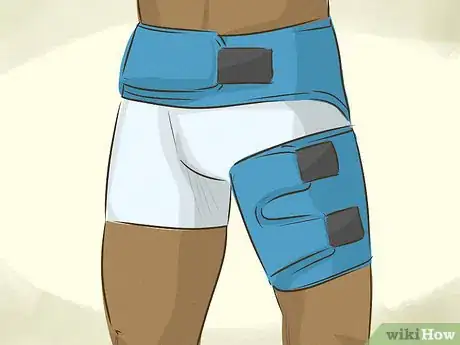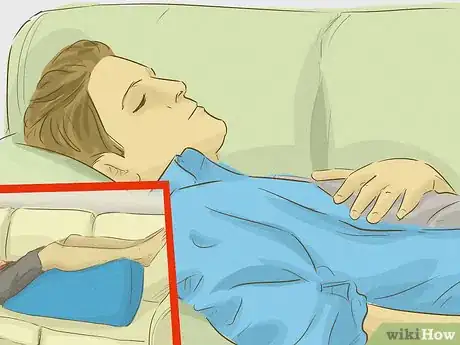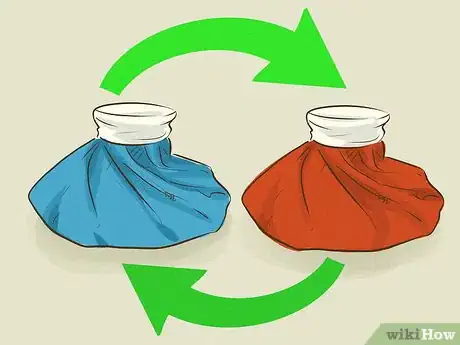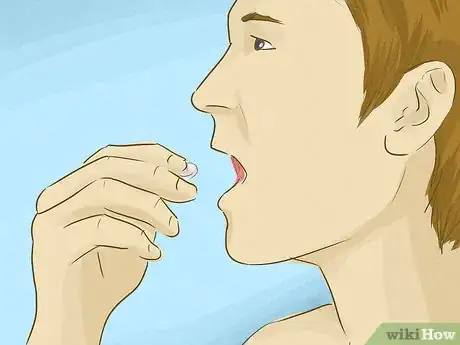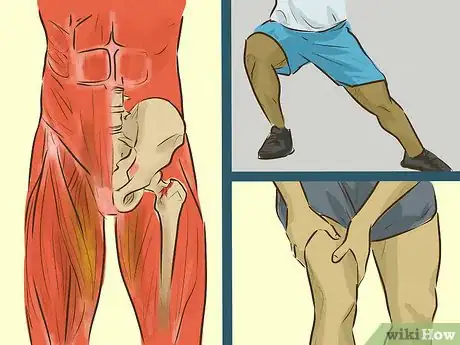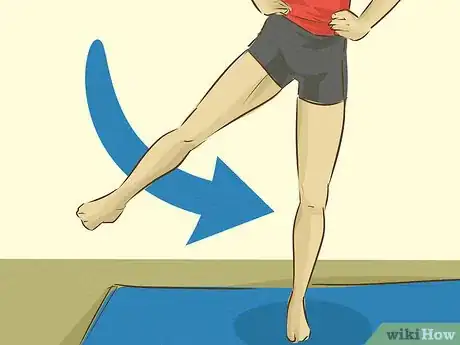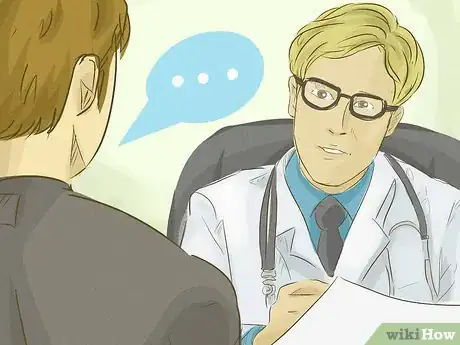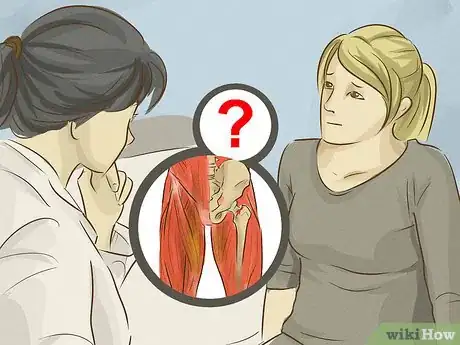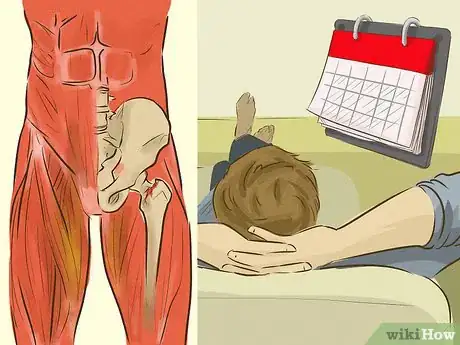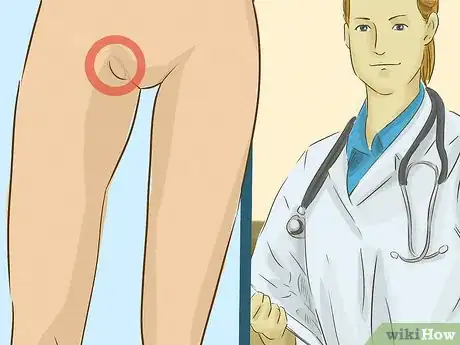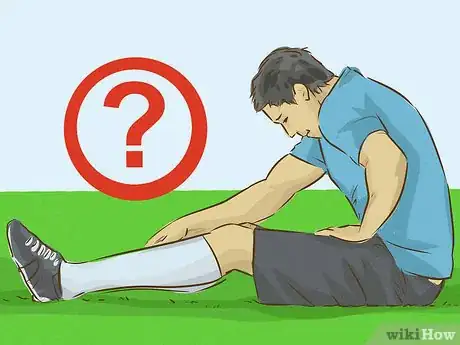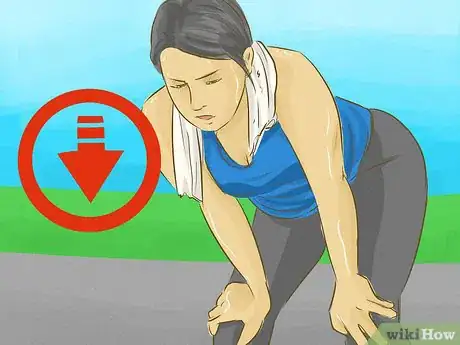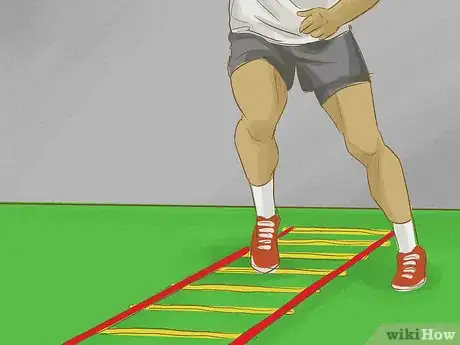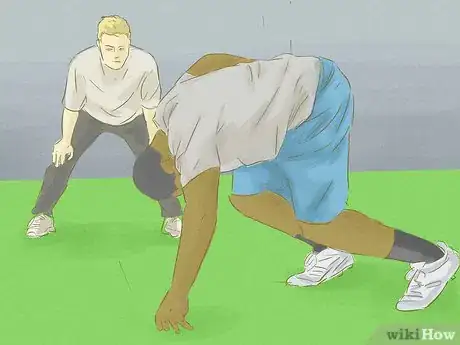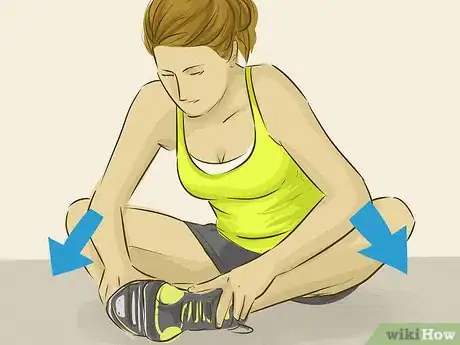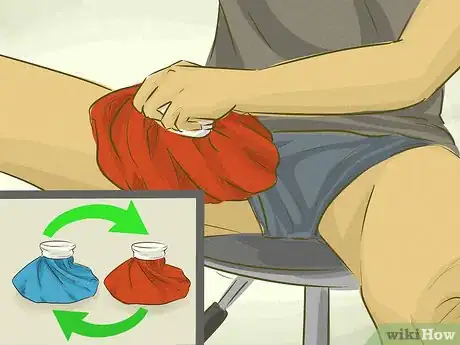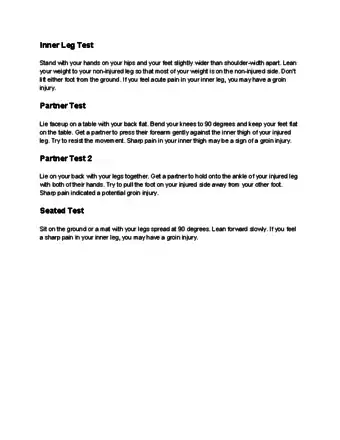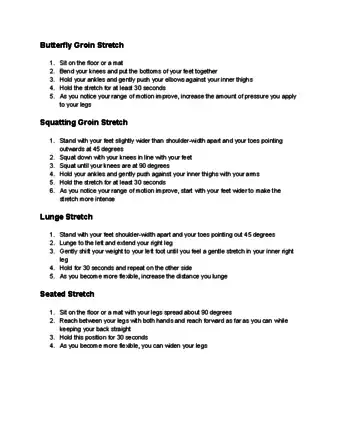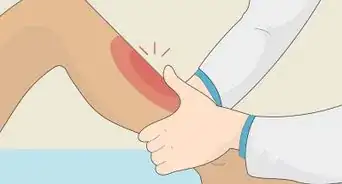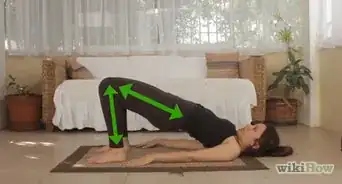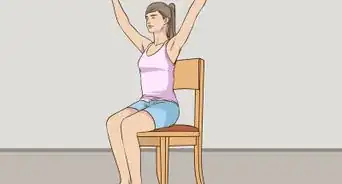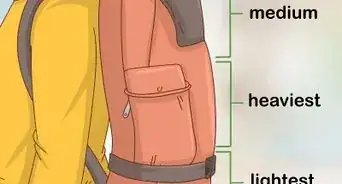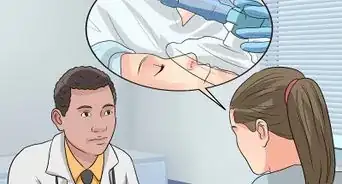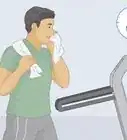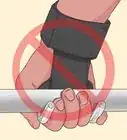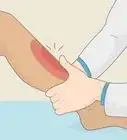This article was medically reviewed by Luba Lee, FNP-BC, MS. Luba Lee, FNP-BC is a Board-Certified Family Nurse Practitioner (FNP) and educator in Tennessee with over a decade of clinical experience. Luba has certifications in Pediatric Advanced Life Support (PALS), Emergency Medicine, Advanced Cardiac Life Support (ACLS), Team Building, and Critical Care Nursing. She received her Master of Science in Nursing (MSN) from the University of Tennessee in 2006.
There are 11 references cited in this article, which can be found at the bottom of the page.
wikiHow marks an article as reader-approved once it receives enough positive feedback. This article received 18 testimonials and 93% of readers who voted found it helpful, earning it our reader-approved status.
This article has been viewed 836,726 times.
The inner thigh pain caused by a groin injury can range from mild to severe, and can happen to anyone at any age. The pain results from a tear or rupture of any one of five muscles that run along the inner thigh, attaching to the pelvic bone at the upper end, and just above the knee area at the other. Treatment requires patience, rest, over-the-counter medication, and a gradual return to activity. Severe injuries and those that are slow to heal warrant medical attention.
Steps
Getting Immediate Relief
-
1Ice the area. Apply ice to the injured area as soon as possible to help limit the swelling, stop any bleeding under the skin, and avoid bruising.[1]
- Apply ice every two to three hours, for 15 minutes each time, for the first 24 to 72 hours following the injury.
- Avoid applying ice directly to the skin. Use an ice pack, crushed ice in a baggie, or frozen veggies like peas, wrapped in a cloth or towel.
- Continue to apply ice for several days after the injury and, upon returning to activity, three to four times each day or directly after mild activity.[2]
-
2Rest. The severity of your groin injury determines how long you need to refrain from physical activity.[3]
- Mild to moderate groin strains require at least two to four weeks of rest. More severe injuries require at least six to eight weeks or even longer for adequate recovery.
- Take at least five to seven days off from physical activity to allow your injury to start healing. Evaluate your pain at that time to determine a gradual return to your sport.
-
3Compress the injured groin muscle. Compression helps to further reduce swelling and stabilize the injured muscle.[4]
- The use of a special brace designed for the groin area is especially helpful. It is made to fit the groin area snugly without being too tight, which can cut off circulation to the region. Braces are available in most drugstores.
- Elastic wraps or groin strapping can also be used, but use caution to avoid wrapping the area too tightly.
-
4
-
5
-
6Take over-the-counter anti-inflammatory agents. Drugs that help reduce inflammation and pain include ibuprofen, naproxen, and aspirin.[9]
- Acetaminophen products available over-the-counter can help with pain management, but do not address inflammation.
- Follow the instructions on the product label, or directions provided by your doctor.
-
7Differentiate the symptoms of a groin injury from other causes. Groin strains or injuries can can have similar symptoms to other conditions, such as a sports hernia.[10] Make sure what you are experiencing is actually a groin strain and not something else.
- The symptoms commonly seen with a groin strain or injury include feelings of tightness or cramping, sudden or sharp pain, and pain when the muscle is either contracted or stretched.[11]
- Severe injuries can include extreme pain even when just walking.[12]
- A sports hernia is indicated by pain in the lower abdomen and groin, pain when coughing or sneezing, and continuing groin pain that flares up when you are active.[13]
- Stress fractures in your femur or pubic bone may cause pain in the groin and spread to your buttocks.[14] You will likely feel pain in the evening, tenderness and swelling, and your symptoms will not improve when you apply rest, ice, compression, and elevation.[15]
- Testicular pain, numbness, tingling, increased swelling, urinary symptoms, and fevers should prompt you to see your doctor to investigate other potential causes.
-
8Perform adduction movements to identify a groin injury. If your symptoms are mild, and you are not sure what type of injury you have, an exercise may help you to determine if you have a groin injury.[16]
- An adduction exercise that helps identify a groin injury involves placing a lightly weighted object, like a medicine ball, between your legs. Try to compress it by gently squeezing your legs together. If this causes you pain, then you most likely have a groin strain.[17]
-
9Seek medical attention if you have a dull ache. A dull and painful ache that gets worse with movement or exercise may indicate a hernia rather than a groin injury.[18]
Seeking Medical Attention
-
1See your doctor to determine the extent of your injury. There are five muscles that support movements of your legs called adduction.[21]
- Adduction means to move inward towards the center of your body. People that commonly experience injuries involving the adductor muscles are athletes that run, kick, sprint, quickly change position, or exert great strength when performing a cross-over motion, as in kicking a soccer ball.[22]
- The five adductor muscles are called the pectineus, adductor brevis, adductor longus, gracilis, and adductor magnus.[23]
-
2Ask your doctor to explain the grade of your injury. Groin injuries are graded based on the severity of the injury.[24]
- Grade 1 injuries are milder and are caused by overstretching one or more of the five muscles, with micro-tearing of muscle fibers within the injury.[25]
- Grade 2 injuries are the most common type, and involve partial tearing of muscle tissue.[26]
- Grade 3 injuries are the most severe, cause more intense pain, and result from complete tearing, or rupture, of one or more of the five muscles.[27]
-
3Anticipate a lengthy recovery period. The amount of time you will need to recover depends on the grade of your injury.[28] In many cases, up to six to eight weeks, or even longer, are needed to allow the muscle tissue to properly heal.
- It is important that you take the time recommended by your doctor in order to prevent re-injury.
-
4Return to your doctor if there is no improvement. If you feel your symptoms are worse, or if you do not see significant improvement within a reasonable amount of time, there may be another cause of the pain.[29]
-
5
Preventing Further Injury
-
1Consider your symptoms. Use the severity of symptoms as a guide to return to activity. Returning to your sport while you still have pain can lead to subsequent injury.
- Avoid activity if you have any pain. Do not walk quickly, jog, or run, if you have any pain.
- Once you are pain-free, resume your activity very gradually to prevent further injury.
-
2Reduce your activity if you feel pain. As you begin to resume your activity, pay attention to your body signals and respect the limits of your body. Notice pain that goes beyond the normal "burn" of exercise and take it as a signal to stop what you are doing.[34] You want to challenge yourself during your workout, but you don't want to push yourself to the point of injuring yourself again.
- If you feel pain during your activity, then reduce the intensity or duration and work back towards that level more gradually.[35] It may be frustrating, but it would be even more frustrating to have to sit out after re-injuring yourself.
- Persistent pain may indicate a greater potential to reinjure the area or may be a warning sign that another underlying injury may be involved. Back down on the intensity or duration of exercise until the pain improves. See your doctor if the pain persists.[36]
-
3Copy the movements of your sport. Slowly go through the movements that you will need to accomplish in order to actively participate in your sport.
- Move slowly but deliberately, avoiding weight or friction, to determine if you are pain-free before you return to actively participating.
-
4Work with a trainer. A trainer who is knowledgeable in your sport can not only help you to recover up to 100% of your capacity, but can also teach you the proper warm up and stretching activities that will help you avoid future injury.
-
5Warm up and stretch. A major cause of groin injury is the lack of proper warm up and stretching exercises prior to physical activity.[37]
- Stretching loosens the adductor muscle and prepares it for activity, while a sufficient warm up period before exercise gets the blood flowing to the muscle and preps it to work properly under stress.[38]
- Massaging the area can also help get blood flowing and warm up your joints.
- Perform a simple stretch that targets the groin area before and after you work out or participate in sports. Sit on the floor with your back gently against the wall. Place the bottoms of your feet together and pull your feet in toward your groin. Gently and slowly move your knees toward the floor. Hold this stretch for 20 seconds and repeat once.[39]
-
6
Help Identifying, Preventing, and Treating Groin Injuries
Expert Q&A
-
QuestionWould wrapping it or wearing compression shorts help the athlete avoid reinjury once they resume activity?
 Luba Lee, FNP-BC, MSLuba Lee, FNP-BC is a Board-Certified Family Nurse Practitioner (FNP) and educator in Tennessee with over a decade of clinical experience. Luba has certifications in Pediatric Advanced Life Support (PALS), Emergency Medicine, Advanced Cardiac Life Support (ACLS), Team Building, and Critical Care Nursing. She received her Master of Science in Nursing (MSN) from the University of Tennessee in 2006.
Luba Lee, FNP-BC, MSLuba Lee, FNP-BC is a Board-Certified Family Nurse Practitioner (FNP) and educator in Tennessee with over a decade of clinical experience. Luba has certifications in Pediatric Advanced Life Support (PALS), Emergency Medicine, Advanced Cardiac Life Support (ACLS), Team Building, and Critical Care Nursing. She received her Master of Science in Nursing (MSN) from the University of Tennessee in 2006.
Board-Certified Family Nurse Practitioner Compression shorts might help with stability of the area; however, educating yourself about proper body mechanic and not lifting very heavy weights is more essential in preventing groin injuries.
Compression shorts might help with stability of the area; however, educating yourself about proper body mechanic and not lifting very heavy weights is more essential in preventing groin injuries. -
QuestionWhat home remedy can I use to treat a groin pull?
 Luba Lee, FNP-BC, MSLuba Lee, FNP-BC is a Board-Certified Family Nurse Practitioner (FNP) and educator in Tennessee with over a decade of clinical experience. Luba has certifications in Pediatric Advanced Life Support (PALS), Emergency Medicine, Advanced Cardiac Life Support (ACLS), Team Building, and Critical Care Nursing. She received her Master of Science in Nursing (MSN) from the University of Tennessee in 2006.
Luba Lee, FNP-BC, MSLuba Lee, FNP-BC is a Board-Certified Family Nurse Practitioner (FNP) and educator in Tennessee with over a decade of clinical experience. Luba has certifications in Pediatric Advanced Life Support (PALS), Emergency Medicine, Advanced Cardiac Life Support (ACLS), Team Building, and Critical Care Nursing. She received her Master of Science in Nursing (MSN) from the University of Tennessee in 2006.
Board-Certified Family Nurse Practitioner You should rest, limit activity, and can take 400 mg ibuprofen every 4 to 6 hours for mild to moderate pain in your groin. Ibuprofen is nonsteroidal anti-inflammatory (NSAID) medication that is commonly used for pulled muscles, sprains and strains.
You should rest, limit activity, and can take 400 mg ibuprofen every 4 to 6 hours for mild to moderate pain in your groin. Ibuprofen is nonsteroidal anti-inflammatory (NSAID) medication that is commonly used for pulled muscles, sprains and strains.
References
- ↑ http://www.sportsinjuryclinic.net/sport-injuries/hip-groin-pain/groin-strain
- ↑ http://www.physioadvisor.com.au/9464750/groin-strain-adductor-strain-physioadvisor.htm
- ↑ http://www.mountsinai.org/patient-care/health-library/diseases-and-conditions/groin-strain
- ↑ http://www.mountsinai.org/patient-care/health-library/diseases-and-conditions/groin-strain
- ↑ http://www.mountsinai.org/patient-care/health-library/diseases-and-conditions/groin-strain
- ↑ http://www.drugs.com/cg/groin-strain-aftercare-instructions.html
- ↑ http://www.mountsinai.org/patient-care/health-library/diseases-and-conditions/groin-strain
- ↑ http://www.mountsinai.org/patient-care/health-library/diseases-and-conditions/groin-strain
- ↑ http://www.coreperformance.com/knowledge/injury-pain/groin-strain.html
- ↑ http://www.physioadvisor.com.au/9464750/groin-strain-adductor-strain-physioadvisor.htm
- ↑ http://www.physioadvisor.com.au/9464750/groin-strain-adductor-strain-physioadvisor.htm
- ↑ http://www.physioadvisor.com.au/9464750/groin-strain-adductor-strain-physioadvisor.htm
- ↑ http://www.totalperformancept.com/2013/02/15/groin-strain-or-sports-hernia/
- ↑ http://www.sports-health.com/sports-injuries/groin-injuries/common-types-groin-injury
- ↑ http://www.sports-health.com/sports-injuries/groin-injuries/common-types-groin-injury
- ↑ http://www.physioadvisor.com.au/9464750/groin-strain-adductor-strain-physioadvisor.htm
- ↑ http://www.physioadvisor.com.au/9464750/groin-strain-adductor-strain-physioadvisor.htm
- ↑ http://www.physioadvisor.com.au/9464750/groin-strain-adductor-strain-physioadvisor.htm
- ↑ http://www.physioadvisor.com.au/9464750/groin-strain-adductor-strain-physioadvisor.htm
- ↑ http://www.physioadvisor.com.au/9464750/groin-strain-adductor-strain-physioadvisor.htm
- ↑ http://www.sportsinjuryclinic.net/sport-injuries/hip-groin-pain/groin-strain
- ↑ http://www.sportsinjuryclinic.net/sport-injuries/hip-groin-pain/groin-strain
- ↑ http://www.sportsinjuryclinic.net/sport-injuries/hip-groin-pain/groin-strain
- ↑ http://www.mountsinai.org/patient-care/health-library/diseases-and-conditions/groin-strain
- ↑ http://www.mountsinai.org/patient-care/health-library/diseases-and-conditions/groin-strain
- ↑ http://www.mountsinai.org/patient-care/health-library/diseases-and-conditions/groin-strain
- ↑ http://www.mountsinai.org/patient-care/health-library/diseases-and-conditions/groin-strain
- ↑ http://www.mountsinai.org/patient-care/health-library/diseases-and-conditions/groin-strain
- ↑ http://www.nlm.nih.gov/medlineplus/ency/article/003111.htm
- ↑ http://www.nlm.nih.gov/medlineplus/ency/article/003111.htm
- ↑ http://www.mayoclinic.org/symptoms/groin-pain/basics/causes/sym-20050652
- ↑ http://www.mayoclinic.org/symptoms/groin-pain/basics/causes/sym-20050652
- ↑ http://www.mayoclinic.org/symptoms/groin-pain/basics/causes/sym-20050652
- ↑ http://www.physioadvisor.com.au/9464750/groin-strain-adductor-strain-physioadvisor.htm
- ↑ http://www.physioadvisor.com.au/9464750/groin-strain-adductor-strain-physioadvisor.htm
- ↑ http://www.physioadvisor.com.au/9464750/groin-strain-adductor-strain-physioadvisor.htm
- ↑ http://www.sportsinjuryclinic.net/sport-injuries/hip-groin-pain/groin-strain/stretching-for-a-groin-strain
- ↑ http://www.sportsinjuryclinic.net/sport-injuries/hip-groin-pain/groin-strain/stretching-for-a-groin-strain
- ↑ http://www.sportsinjuryclinic.net/sport-injuries/hip-groin-pain/groin-strain/stretching-for-a-groin-strain
- ↑ http://www.physioadvisor.com.au/9464750/groin-strain-adductor-strain-physioadvisor.htm
- ↑ http://www.mountsinai.org/patient-care/health-library/diseases-and-conditions/groin-strain
About this article
To treat a groin injury, apply ice to the area as soon as possible to reduce the swelling. Continue to apply ice for 15 minute intervals every 2 hours for the first 48 hours after the injury. Additionally, take painkillers, like ibuprofen or aspirin, to manage the pain. You should also elevate the affected area above your hip to reduce blood flow and swelling, and wrap it in elastic strapping to compress the muscle. However, if you notice a lump near the affected area or pain in your abdomen, see a doctor to determine how serious your injury is. For tips on how to differentiate a groin strain from other injuries, like a hernia, read on!
